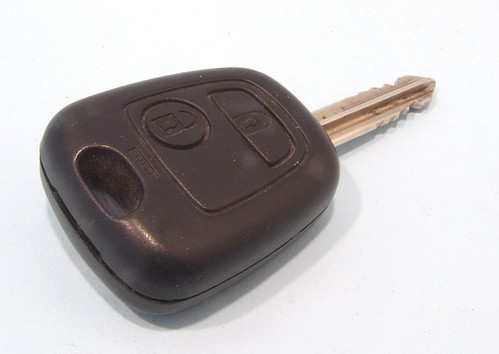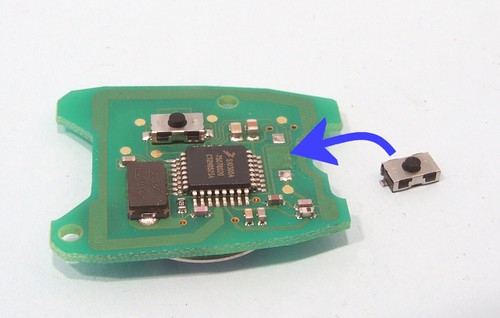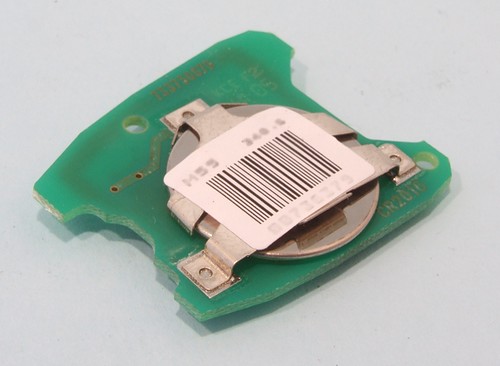 The problem - Pressing the lock button on our Berlingo's keyfob didn't lock the doors. The unlock button worked OK though.
The problem - Pressing the lock button on our Berlingo's keyfob didn't lock the doors. The unlock button worked OK though.First thoughts were that the battery in the keyfob was on its way out. A quick check with Timpsons and Halfords suggested that you have to get a dealer to change this and any other course of action WILL RESULT IN DOOM. Apparently, if the battery is out for more than 30 seconds, the fob loses its memory and has to be reprogrammed.
Anyway, we trundled down to the our local dealer and had a chat with the service department. They could change the battery and went off to do this. A few minutes later they returned with the fob and explained it wasn't the battery.
Under the rubberyplastic buttons, the switches are surface mount buttons and one of those had become detached from the circuit board. This explained why the lock button felt soft - it wasn't pressing on anything.
Now we had two options. A new fob is £150 because it has to be programmed. However, the helpful guy suggested that if I was handy with a soldering iron, I could fix it myself. Well, as regular readers will know, I AM pretty handy with the solder so I reckoned it was worth a go. After all, we still had the switch which had been rattling around in the fob. They even helpfully put it in an envelope so I didn't lose it.
Back home, I opened the fob by twisting a 20p coin in the top, fired up my Maplin soldering station, placed a tiny bit of Copalux flux on the solder pads, popped the switch in position and heated the joints until the solder melted. This took a couple of seconds for each joint - if you try this, don't leave the iron on too long, just watch the solder melt, take the heat away and blow on the joint.
 I'll admit I did take the time to look at the switch and work out which way around it was before it fell off. The shape of the solder joints give that away, but I doubt very much if it really matters.
I'll admit I did take the time to look at the switch and work out which way around it was before it fell off. The shape of the solder joints give that away, but I doubt very much if it really matters.
Before putting the circuit board back in the key, I took it out and tested my efforts with the car - everything worked perfectly.
The board was placed in the fob, snapped back together and has worked fine ever since.
Not a bad repair. Even if I'd had to buy all the equipment (soldering station, flux and a tiny bit of solder) this would still be less than the official repair.
I suspect that if the switch had been glued back into position with the contacts touching the solder pads, it would probably still work. The result wouldn't be as good as solder but if it's what you've got... Just don't get glue on the solder pads, pop a tiny amount under the switch body. Superglue applied with a pin would be best (place a drop on glue on some plastic and pick a tiny drop up with the end of a pin) but, I stress, I've not tried this it was my plan B.
But what if it had been the battery?
Well, the service guys took the battery out of the fob while I was there, left it for a few seconds and slid it back in. No tools were required and more importantly, no DOOM happened.
As far as I can tell (and I've not tried it but can't see a problem), you just slide the old battery out by pushing it gently and slide in a new one. According to the circuit board, it takes a CR2016 cell which is commonly available in the shops. Have one to hand before you fiddle with it and there is no chance you'll have the battery out for greater than 30 seconds thus bringing DOOM upon you, if you believe that sort of thing. My suspicion is that the 30 second rule applies to more complicated keyfobs than the Berlingo one but it's safer to say no to all of them and let the dealer, who should know about these things, take the risk of poking around.
Anyway, thanks very much to the service guys at Murley Citroen (Leamington Branch), who could have tried it on by telling us the fob had broken in an effort to sell a new one. Instead, they took a few minutes to explain the problem, apologise that they couldn't fix it, and then make a sensible suggestion. If I were in the market for a new car, it's the first place I'd go.
Legal note: This is an accurate description of what I did. Follow these notes at your own discretion. If it all goes wrong, it's not my fault. If you aren't confident, get a professional to take a look.
 I'll admit I did take the time to look at the switch and work out which way around it was before it fell off. The shape of the solder joints give that away, but I doubt very much if it really matters.
I'll admit I did take the time to look at the switch and work out which way around it was before it fell off. The shape of the solder joints give that away, but I doubt very much if it really matters.Before putting the circuit board back in the key, I took it out and tested my efforts with the car - everything worked perfectly.
The board was placed in the fob, snapped back together and has worked fine ever since.
Not a bad repair. Even if I'd had to buy all the equipment (soldering station, flux and a tiny bit of solder) this would still be less than the official repair.
I suspect that if the switch had been glued back into position with the contacts touching the solder pads, it would probably still work. The result wouldn't be as good as solder but if it's what you've got... Just don't get glue on the solder pads, pop a tiny amount under the switch body. Superglue applied with a pin would be best (place a drop on glue on some plastic and pick a tiny drop up with the end of a pin) but, I stress, I've not tried this it was my plan B.
But what if it had been the battery?
Well, the service guys took the battery out of the fob while I was there, left it for a few seconds and slid it back in. No tools were required and more importantly, no DOOM happened.
As far as I can tell (and I've not tried it but can't see a problem), you just slide the old battery out by pushing it gently and slide in a new one. According to the circuit board, it takes a CR2016 cell which is commonly available in the shops. Have one to hand before you fiddle with it and there is no chance you'll have the battery out for greater than 30 seconds thus bringing DOOM upon you, if you believe that sort of thing. My suspicion is that the 30 second rule applies to more complicated keyfobs than the Berlingo one but it's safer to say no to all of them and let the dealer, who should know about these things, take the risk of poking around.
Anyway, thanks very much to the service guys at Murley Citroen (Leamington Branch), who could have tried it on by telling us the fob had broken in an effort to sell a new one. Instead, they took a few minutes to explain the problem, apologise that they couldn't fix it, and then make a sensible suggestion. If I were in the market for a new car, it's the first place I'd go.
Legal note: This is an accurate description of what I did. Follow these notes at your own discretion. If it all goes wrong, it's not my fault. If you aren't confident, get a professional to take a look.


6 comments:
We've just had a similar problem with the key for our Citroen C3. Unfortunately the unlock button doesn't work and the lock button isn't reliable. I changed the battery (no DOOM descended on me) and while the lock button still worked occasionally it wasn't any better. I did look at the switches but the solder looked intact so I'm guessing the fault on ours is different. Cost of a replacement is £160 and at least a 10 day wait for the new key (should be here on Monday).
One interesting thing to add is how you lock the doors if the fob button doesn't work. On our car only the drivers door has a key hole. While unlocking the drivers door turns off the central locking, locking it doesn't lock all the doors. If the fob button doesn't work this leaves you with a car with only the drivers door locked. The trick is to shut all four doors, open the boot, and then use a long pole (a broom handle is what we are using) to push the central locking button on the dashboard. This locks all the doors and when you shut the boot this gets locked as well. You do look funny when doing this in a busy car park though.
A wooden central locking operating tool? Sounds fien to me although I suspect less appealing in Sainsburys car park!
Do you think the idea that the key has to be re-programmed if you take the battery out is true? It's my understanding that the key has an RFID tag in it, and when the dealer 'programs the key' what they are really doing is programming the CAR, to recognize the key.
I think the keys are all different. RFID tags are (I suspect) more sophisticated than those in the Berlingo fob. Ican see programming the car to the fob too.
As I say, if you aren't sure then go to a dealer. I suspect this is why Halfords and Timpsons give this advice.
Mark - If I recall the manual on the C5 (ok the C3 may be different) the internal button lock doesn't enable the ultrasonic intrusion detection.
This is because it assumes someone is in the car (to push the button) and that would be the ultrasonic would set the alarm off as soon as they moved.
A similar fault of bad buttons on the C3 is repaired by replacing the switches on the circuit board and shown on the forum at https://citroenc3owners.com/citroen-c3-tips/early-c3-transponder-key-fob-parts-plip-fix-t449.html
Post a Comment